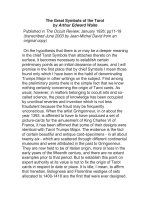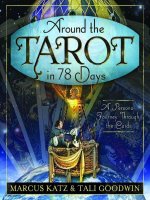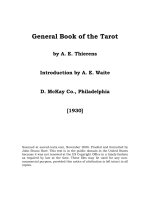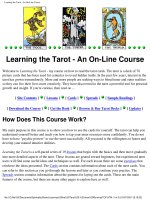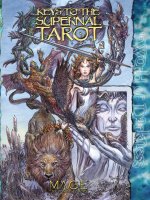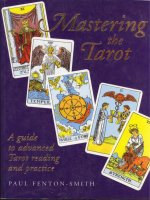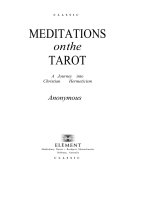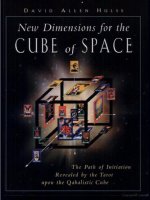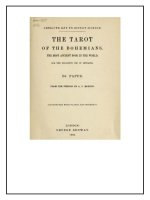Hướng dẫn bói bài Tarot Around the tarot in 78 days a personal katz,marcus
Bạn đang xem bản rút gọn của tài liệu. Xem và tải ngay bản đầy đủ của tài liệu tại đây (5.46 MB, 306 trang )
—About the Authors—
Marcus Katz
Marcus Katz is a professional tarot teacher at the Far Away Centre, a contemporary training
centre in the Lake District of England. As the co-Director of Tarot Professionals, the
world’s largest professional tarot organization, he has studied and taught tarot for thirty
years and has delivered more than 10,000 face-to-face readings. His first book, Tarosophy,
has been termed a “major contribution” to tarot by leading teachers. Marcus is also the cocreator of Tarot-Town, the social network for tarot, with over 10,000 people worldwide
sharing innovative tarot development.
Tali Goodwin
Tali Goodwin is the Marketing Director and co-founder of Tarot Professionals Ltd., the
largest professional tarot organization in the world. She has co-authored innovative teaching
books such as Tarot Flip, which is regularly in the top ten best-selling tarot books on
Kindle. Tali is a skilled researcher and is credited with bringing the long-hidden WaiteTrinick Tarot to publication in Abiding in the Sanctuary: The Waite-Trinick Tarot. She also
co-edited the leading tarot magazine, Tarosophist International, from 2010–11.
Llewellyn Publications
Woodbury, Minnesota
Copyright Information
Around the Tarot in 78 Days:A Personal Journey Through the Cards © 2012 by Marcus Katz and Tali
Goodwin
All rights reserved. No part of this book may be used or reproduced in any matter whatsoever, including
Internet usage, without written permission from Llewellyn Publications, except in the form of brief
quotations embodied in critical articles and reviews.
As the purchaser of this e-book, you are granted the non-exclusive, non-transferable right to access and
read the text of this e-book on screen. The text may not be otherwise reproduced, transmitted, downloaded,
or recorded on any other storage device in any form or by any means.
Any unauthorized usage of the text without express written permission of the publisher is a violation of the
author’s copyright and is illegal and punishable by law.
First e-book edition © 2012
E-book ISBN: 9780738731438
Book design by Bob Gaul
Cover art: Illustration © Autumns Goddess Design/Jena DellaGrottaglia
Tarot cards © Universal Tarot © Roberto De Angelis—LoScarabeo
Cover design by Ellen Lawson
Editing by Laura Graves
Interior tarot card art (reprinted by permission):
Legacy of the Divine Tarot © Ciro Marchetti—Llewellyn
Shadowscapes Tarot © Stephanie Pui-Mun Law and Barbara Moore—Llewellyn
Universal Tarot © Roberto De Angelis—LoScarabeo
Ithell Colquhoun Tarot—Adam McLean
Other interior illustrations © Llewellyn Art Department
Llewellyn Publications is an imprint of Llewellyn Worldwide Ltd.
Llewellyn Publications does not participate in, endorse, or have any authority or responsibility concerning
private business arrangements between our authors and the public.
Any Internet references contained in this work are current at publication time, but the publisher cannot
guarantee that a specific reference will continue or be maintained. Please refer to the publisher’s website
for links to current author websites.
Llewellyn Publications
-1-
Llewellyn Worldwide Ltd.
2143 Wooddale Drive
Woodbury, MN 55125
www.llewellyn.com
Manufactured in the United States of America
-2-
Contents
—About the Authors— ................................................................. 1
Dedications .......................................................................... 6
Acknowledgments ..................................................................... 6
Introduction .......................................................................... 7
Let’s Get Started ...................................................................... 7
Section One: Packing for the Journey ...................................................... 7
Section Two: Your Tarot Mapbook........................................................ 8
Section Three: Your Tarot Phrasebook .................................................... 15
Section Four: Your Tarot Guidebook ..................................................... 18
Section Five: Your Emergency Kit ....................................................... 19
—Day 1: Page of Pentacles— ........................................................... 30
—Day 2: Page of Swords— ............................................................ 33
—Day 3: Page of Cups— .............................................................. 36
—Day 4: Page of Wands— ............................................................. 38
Elemental Spread—For Finding Your Place ................................................ 48
—Day 5: Ten of Pentacles— ............................................................ 50
—Day 6: Ten of Swords— ............................................................. 52
—Day 7: Ten of Cups— ............................................................... 55
—Day 8: Ten of Wands— .............................................................. 58
—Day 9: The World— ................................................................ 60
—Day 10: The Last Judgement— ........................................................ 63
—Day 11: The Moon—................................................................ 65
Rainbow Spread—For Changing Your Pattern .............................................. 68
—Day 12: Nine of Pentacles— .......................................................... 70
—Day 13: Nine of Swords— ........................................................... 72
—Day 14: Nine of Cups— ............................................................. 75
—Day 15: Nine of Wands— ............................................................ 77
—Day 16: The Sun— ................................................................. 79
—Day 17: The Star— ................................................................. 82
—Day 18: Temperance— .............................................................. 84
Escape Spread—For Finding Hope When Lost ............................................. 87
—Day 19: Eight of Pentacles— ......................................................... 88
—Day 20: Eight of Swords— ........................................................... 90
—Day 21: Eight of Cups— ............................................................. 92
—Day 22: Eight of Wands— ........................................................... 94
—Day 23: The Hanged Man— .......................................................... 97
—Day 24: The Devil— ................................................................ 99
—Day 25: The Blasted Tower— ........................................................ 101
Escape Spread—For Escaping Temptation ................................................ 104
—Day 26: Seven of Pentacles— ........................................................ 105
—Day 27: Seven of Swords— ......................................................... 107
—Day 28: Seven of Cups— ........................................................... 109
—Day 29: Seven of Wands— .......................................................... 111
—Day 30: Death— .................................................................. 115
—Day 31: The Wheel— .............................................................. 118
-3-
Solar Spread—For Opening to the Light.................................................. 120
—Day 32: Six of Pentacles— .......................................................... 121
—Day 33: Six of Swords— ............................................................ 124
—Day 34: Six of Cups—.............................................................. 126
—Day 35: Six of Wands— ............................................................ 128
—Day 36: Justice—.................................................................. 131
—Day 37: The Lovers— .............................................................. 133
—Day 38: The Emperor— ............................................................ 135
—Day 39: The Hermit— .............................................................. 139
Shadow Spread—For Facing Fears ...................................................... 142
—Day 40: Knight of Pentacles— ....................................................... 143
—Day 41: Knight of Swords— ......................................................... 146
—Day 42: Knight of Cups— ........................................................... 148
—Day 43: Knight of Wands— ......................................................... 150
Abyss Spread—For Letting Go ......................................................... 164
—Day 44: Five of Pentacles— ......................................................... 165
—Day 45: Five of Swords— ........................................................... 168
—Day 46: Five of Cups— ............................................................. 171
—Day 47: Five of Wands— ........................................................... 173
—Day 48: The Chariot— ............................................................. 175
—Day 49: Strength— ................................................................ 178
Pyramid Spread—For Entering The Mysteries ............................................. 180
—Day 50: Four of Pentacles— ......................................................... 182
—Day 51: Four of Swords—........................................................... 185
—Day 52: Four of Cups— ............................................................ 187
—Day 53: Four of Wands— ........................................................... 190
—Day 54: The Hierophant— .......................................................... 193
—Day 55: Three of Pentacles— ........................................................ 195
—Day 56: Three of Swords— .......................................................... 198
—Day 57: Three of Cups—............................................................ 200
—Day 58: Three of Wands— .......................................................... 203
—Day 59: The Empress— ............................................................ 206
—Day 60: Queen of Pentacles—........................................................ 209
—Day 61: Queen of Swords— ......................................................... 212
—Day 62: Queen of Cups— ........................................................... 217
—Day 63: Queen of Wands—.......................................................... 220
Devotion Spread—For Returning Home .................................................. 226
—Day 64: Two of Pentacles— ......................................................... 227
—Day 65: Two of Swords— ........................................................... 229
—Day 66: Two of Cups—............................................................. 232
—Day 67: Two of Wands— ........................................................... 235
—Day 68: King of Pentacles— ......................................................... 238
—Day 69: King of Swords— .......................................................... 241
—Day 70: King of Cups— ............................................................ 244
—Day 71: King of Wands— ........................................................... 247
The Crown Spread—For Finding Yourself ................................................ 251
—Day 72: The High Priestess— ........................................................ 252
-4-
—Day 73: The Magician— ............................................................ 254
—Day 74: Ace of Pentacles—.......................................................... 258
—Day 75: Ace of Swords— ........................................................... 261
—Day 76: Ace of Cups— ............................................................. 263
—Day 77: Ace of Wands—............................................................ 265
—Day 78: The Fool— ................................................................ 268
Conclusion: ........................................................................ 270
Our Website Links ................................................................... 270
Further Links ....................................................................... 271
Reading List........................................................................ 272
Appendix 1: ........................................................................ 273
The 78-Day Tarot Tale ............................................................... 273
Appendix 2: The Tarosophy Code ...................................................... 276
Endnotes .......................................................................... 303
-5-
Dedications
This book is dedicated to all those townsfolk, citizens, and honoured patrons of Tarot Town.com who engage tarot with life and share their experience and insight. You can
discover an active and passionate study group for the 78 Days workbook in Tarot-Town.
We would particularly like to dedicate this work to the main road-testers of 78 Days, the
gifted and talented tarot readers Shannon Gorton, Sarah Perks, Nadine Roberts, Claire
Greener, Jennifer Dickensheets, Jera Babylon Rootweaver, Ann (Pearl) Coghlan, Annick
Van Damme, Carole McCleery, Linette Voller, Sharon Woolf, and Donna. To the other
240+ readers and students who read through the entire course and offered suggestions, this
work is also dedicated to you.
Around the Tarot in 78 Days is most deeply dedicated to our partners, leading astrologer
Lyn Birkbeck (who also kindly provided the Sabian Symbols nameplates from his work The
Astrological Oracle) and author Brina Katz, whose patience and inspiration supported the
writing of every word of this book.
Dedicated to my father for his continual support and for buying me the Encyclopaedia of
Tarot for a Christmas present in 1985, when I was seven years into my tarot studies.
—Marcus Katz
Dedicated to my mother, Margaret Goodwin (1929–1990), in memory of her loving grace
and my father, Geoffrey Goodwin (1924–1996). To my sister Avril Garside for being there
from the beginning.
—Tali Goodwin
As ever, and above all, this book is spiritually dedicated to Anistita Argenteum Astrum, The
Priestess of the Silver Star.
She whose light leads the way to the Arcanum Arcanorum, the Secret of Secrets.
Vos Vos Vos Vos.
V. V. V .V.
Acknowledgments
We would like to acknowledge Barbara Moore for providing the opportunity to create this
workbook from our courses and teachings, and the members of Tarot Professionals whose
encouragement and support over the years continue to raise the level of tarot worldwide.
A number of the techniques in this workbook have been created from our work in NLP,
Neuro-Linguistic Programming. Marcus is a licensed trainer of NLP with the Society of
NLP with over twenty years experience and would like to acknowledge the creative work of
Richard Bandler, John Grinder, Robert Dilts, Doug O’ Brien, and Stephen Gilligan,
amongst many of those whose training continues to inspire him, assist clients, and provide
new ways of teaching tarot.
-6-
Introduction
I
n this book, you are going to discover that the tarot is not just a deck of seventy-eight
cards; it is a real place—a place where your mind meets the mysteries and your imagination
floats over the landscape of time itself, gaining insight into your past, present, and future. It
is into this magical place that we are going to travel together, on a tour around the tarot in
seventy-eight days.
This book contains a progressive and comprehensive tarot course that can be completed a
day at a time, or ad-hoc, and then used as an invaluable reference guide as you continue to
deepen your studies and practices in the future. It is written for absolute beginners to enjoy
and seasoned readers to gain new ways of looking at their work.
On this journey, you will be introduced to each and every card as an exciting adventure of
discovery, building up a conversation with the whole deck by learning new methods and
insights along the way. These include tarot spreads for reading for yourself and others, and
new methods to fully deepen your experience of the cards.
We will ensure that you are fully prepared by packing your map, phrasebook and guidebook,
your compass—and even an emergency kit!
Over the years we have been teaching tarot, we know from thousands of students that the
best way to learn tarot is to have fun, to engage in-depth with the deck as a living landscape
and a voyage of self-discovery. You will soon visit such mystical places as the Clockwork
Museum and the Mountain of the Sun, where you will find tarot gates opening up whole
new areas in your life.
In fact, in no time at all, you will be working with the tarot to divine your future, change
your present, and understand your past—and these seventy-eight days will open your
magical and personal journey through the cards.
We are delighted to have you along for this trip of a lifetime.
Let’s Get Started
Section One: Packing for the Journey
As with any journey, we need to first pack whatever we might need on the way. You won’t
need any other equipment for this workbook other than the book itself and a pack of tarot
cards. The workbook is structured around the standard deck of seventy-eight cards (twentytwo majors, forty minors, and sixteen court cards) so you will need to ensure you have this
type of deck rather than an “Oracle” or variant deck. It doesn’t matter if the deck is
-7-
illustrated or a “pips-only” deck, although you will probably find it easier with a deck such
as the Waite-Smith Tarot or other “clone” deck based on that model.
You may like to use any of the following decks which illustrate this book:
Shadowscapes Tarot (Stephanie Pui-Mun Law & Barbara Moore, Llewellyn)
The Legacy of the Divine Tarot (Ciro Marchetti, Llewellyn)
The Universal Tarot (Roberto de Angelis, Lo Scarabeo)
We also refer to the Thoth Tarot deck by Aleister Crowley and Frieda Harris during our
journey ahead. There are many online sites that provide images and reviews of decks for
you.1 We also love the limited edition majors-only and other decks of our friends at:
Adam McLean Artwork Tarot (www.alchemywebsite.com/tarot/tarot_decks.html)
Beth Seilonen Tarot (www.catseyeart.com)
We refer to the Waite-Smith Tarot or its various versions as WST throughout this workbook.
You may wish to keep a journal of your tarot travels as you explore this workbook. We
would highly recommend this recording of your experiences, particularly if you take the
route of the ten gated spreads we have provided in the journey. A journal can be a simple
notebook or a treasured handmade item; each traveller must decide what suits his or her
style.
Having packed the bare essentials, let’s take a look now at the landscape we are about to
explore, and then we can decide what else we might require before setting off.
Section Two: Your Tarot Mapbook
The Tarot Landscape
The incredible country in which you are about to travel is a place with which you already
have familiarity. In fact, you already spend all of your time there; it’s just that you don’t
notice. Tarot is a place of dreams, symbols, and the unconscious. When you see a red light
and stop, when you see two doors with a male and female figure on them, when you say
“life is like a box of chocolates” you are already living in the symbolic landscape of tarot.
You have practiced tarot your whole life—in dreams and in waking.
The tarot landscape of the unconscious mind is one that has been explored in many films,
most recently The Matrix and Inception. Tarot, however, is a particular place. Whilst it
follows dream rules, we can soon learn to find our way around using signposts and learning
the language of the place.
The Landmark Cards (Major Arcana)
There are twenty-two significant landmarks in the landscape—these are the twenty-two
major arcana. In our life these are always present at every moment; they are so big we can
see them from anywhere and get our bearings. We are never lost when we use these
landmarks to discover where we are. In fact in Kabbalah these twenty-two landmarks
-8-
correspond to the twenty-two Hebrew letters which create the entire language. Each of them
has its own path on the Tree of Life so we can discover our way along the spiritual journey.
At any time in your life journey you may be closer to some of these landmarks than others.
You can guide yourself, as you will discover in this book, in any situation.
In this book we begin from the landscape of the last major arcana card, the World. We then
move upwards through the cards, to the first card of the Magician. This symbolises our
journey in the world to acquire the skill of tarot. Of course we will be accompanied by the
Fool throughout our journey although he will only make an actual appearance when we are
ready.
As an example, suppose you are in an experience or situation to which the Wheel (card X)
is closest. This describes the ups and downs of life. We can see from the Wheel that the
landmark cards closest one way and the other are the Hermit (IX) and Justice (XI). This
tells us we can either move towards removing ourselves from the situation (Hermit) or
balancing it to achieve some outcome (Justice).
Using the landmark cards to guide you is a first step to being confident as a navigator in the
world of tarot. Over the years you may come to use this book and the cards as an invaluable
guide to life, as they are the very map and GPS of our soul.
The Signpost Cards (Minor Arcana)
The minor arcana provide useful signposts in the realm of tarot. When we are working in
any situation the minor arcana provide illustrations of all human activity. As they construct
a matrix in four elements and in ten stages within each element, they also provide a logical
progression, teaching us how to move from one state to another.
We call this the “next step” method.
As you travel over the next seventy-eight days and beyond, you can take any moment to
identify the card in the minors that most sums up your present state and then consult the
page in the workbook for that card. Your “next step” direction is to the following card,
which indicates how you can look to move forwards—simply read the next page for the
way ahead.
The Direction Cards (Court Cards)
The court cards provide us directions in our journey, as they represent the forces at play in
the universe, either through people or through events themselves. We can turn to the court
cards for assistance when we need to kickstart something in our lives or when we feel out of
balance.
Again, as you make our way through a life lived with tarot, if you shuffle your sixteen court
cards whilst considering your present imbalance, then lay them out in a circle, you can
identify which card feels closest to your present state (or use your significator card, which
you will choose here in this workbook) and look across the circle to find your “Kickstart”
court card which is the one now placed opposite to your current state.
Consult the relevant court card page in this workbook, and this will give you the voice of
advice from the card itself in the “[Card] Says” section.
Don’t be afraid to ask for directions if you find yourself a little lost in the world of tarot.
The court cards are always around to assist you.
Pitstop Points
The major arcana can provide our journey and our readings with pitstop points, important
moments when we can take heed and review the fundamental forces that shape our lives.
They are like the deep current on which we sail, often unaware of the tides yet sometimes
-9-
swept up in them. When we know the nature of these points we can quickly adjust our
course to make the most of the flow.
Change Cards
There are several Change cards in the tarot. When these appear in the landscape, change is
foretold, in one of a number of different manners. Whether this change is beneficial or
malign is determined by the other cards in the vicinity.
High Priestess—The change is happening subtly and without your knowledge
Death—The change is happening by transforming the current situation
Blasted Tower—The change is sudden and brings new elements into play
Moon—The change is a slow cycle requiring a long journey
Teaching Cards
When any of the following cards appear in your view, there is a lesson to be learnt, as they
are the main teaching cards of the tarot realm. Actually, all the major cards are lessons and
teachers in some way or another (being images of “archetypes”), but these are most
powerful:
Magician—Direct teaching by experiment and example
Hierophant—Traditional teaching, learning by rote, following a structure
and code
Wheel—Teaching by life experience
Challenge Cards
There are a few cards which present you a challenge to overcome on the way through tarot.
Their appearance in your area brings a call to action and requires response and energy.
Last Judgement—A calling which awakens a new state, if you answer quickly
Opportunity Cards
Whilst all cards present both a challenge and an opportunity, teachings and lessons alike,
some cards open wide opportunities when they appear:
Sun—The opportunity to be open
Lovers—The opportunity to choose
Fool—The opportunity to be free
Initiation Cards
The Initiation cards of the majors are:
Strength—Engaging with the path of right relationship and appropriate response
Chariot—Being on the path with all energies harnessed
- 10 -
Hermit—Becoming the path itself as a living example of the way
Stop Cards
The Stop card of the majors is:
Hanged Man—When this card appears, you should take notice and realise that your values are
being called into question. Make no progress and stop until you are truly manifesting what is most
important to you at this time.
The position of the Hanged Man can show where you are suspended; for example, if in the
past position of a spread, it shows you are still in need of reviewing an experience in
memory. If in the outcome position, it indicates that your current route will take you to a
full stop and review.
We will now take a look at a number of other ways of exploring this tarot landscape.
Going Beyond Spreads
Another manner in which you can use this journey is to provide an innovative way of
working with tarot beyond your own spreads when you read for yourself. A three-card
spread can be converted here to a series of activities or meditations, affirmations, or
oracular advice from the card itself by selecting the “Days” for the cards you have dealt in
answer to your question. This provides a real-life magical ritual to activate the forces of the
cards in daily life.
Gated Spreads
You’ll also be given opportunity in this book to explore the concept of “Gated Spreads,”
which is an intrinsic part of Tarosophy®—tarot to engage life, not escape it. A Gated Spread
is a series of spreads which are linked together by the activities you undertake in response
to each spread. They are designed by “reverse engineering” to ensure you are taken into a
powerful experience if you follow the sequence of spreads and activities they request.
You can only perform a Gated Spread in the sequence it is given; without the activity
between the linked spreads, there is no way in which the next gate will open properly.
Gated Spreads are also used here to teach specific aspects of tarot, Kabbalah, and magick.
The Titles of the Cards
As an intermediate method, once you have begun to learn the basics of each card, we have
given each card two oracular titles that capture the essence of each stage of the journey as
both an invitation and an engagement. Every card along the way presents you an invitation
to learn from it—and a lesson which is experienced if you choose to engage with the card at
that time.
These titles have been drawn from the experience of many hundreds of readers by asking
them unusual questions about the cards which required them to unconsciously process their
deep-seated meanings for the cards in practice rather than from books. In effect, we
processed the cards through thousands of readings to see what they really mean in practice.
Sometimes these were much the same as most accepted meanings in books, sometimes they
were very different and yet insightful and relevant to the card.2
When we resolved the keywords from these unconscious responses, we then turned them
into provocative card titles, such as turning “Resources” for the pentacles into “Finding
Yourself … ” or “Ambition” for the wands into “Working Towards … ” These provide the
invitation title.
Furthermore, we have simplified the concepts of Kabbalah in the four worlds of tarot so we
can use the differences of the four suits to generate our engagement titles.
- 11 -
The wands become “expressions,” the cups “creation,” the swords “examination,” and the
pentacles “a place.” These are lowering vibrations in four worlds, from the first emanation
of the wands to the final manifestation of the pentacles. Again, you don’t need to
understand Kabbalah to use the titles as a guide to interpreting the cards; we have simplified
this whilst remaining true to the source. It also means if you plan to study Kabbalah further
in tarot, you will have already picked up a useful background.3
The court card titles are also taken from this research, which shows the pages to be
channelers, the knights to be responders, the queens to be connectors, and the kings to be
demonstrators. Thus, the titles for the invitation/engagement aspects of these cards are:
Pages—Setting & Readiness
Knights—Proving & Responding
Queens—Caring & Being
Kings—Doing & Declaring
You will also see that the titles create your own story through the deck, from the “finding
yourself returning” of the Ten of Pentacles to the “finding the beginning at the end” of the
Fool. The titles for the major arcana are also modified from our earlier work asking
hundreds of readers for unconscious keywords, such as “success” for the Magician and
“revelation” for the High Priestess.
The Order of the Cards
Whilst it may be the usual format to learn the cards one at a time in numerical sequence, the
strangest thing is that you will never get a reading—or only rarely—that follows a number
sequence in order. It is like learning the alphabet and then expecting words to be created
like “abc,” “defg,” “hi,” “jklm,” and so on. We have never found it very important to teach
in number sequence. There are still discussions about the precise order of the majors, such
as swapping the positions of Strength and Justice, and their original order was variable too
because there were sometimes different cards in the early decks.
Similarly, occultists such as A. E. Waite listed the cards naturally from TEN to ACE in that
order because of their background in esotericism and Kabbalah.
We have used a structure here in this workbook based on the soul’s journey on the Tree of
Life. Although we do not cover this in detail, you will experience a trip from the lowest
plane of matter, where we encounter the pages of the court cards and the tens of the minors,
all the way up to the rarefied and abstract heights of the aces and the mysterious High
Priestess, the Magician, and finally the Fool—who is often seen as unnumbered and outside
of any sequence.
The major cards are introduced in order from the World, the highest numbered card, to the
Magician, the lowest numbered card, throughout our journey according to their positions on
the Tree of Life. This provides a good opportunity to learn some of the esoteric patterns in
the tarot without getting too obscure.
- 12 -
The Tarot Card Tree of Life
Connecting with the Cards
As you traverse the tarot, as a quick handbook, you can find for every card a brief
connection sequence, with two levels:
Affirmation
Meditation
These are two progressive stages of connecting with the deeper meanings of each card, and
can provide another “fast-track” route through learning tarot. By using an affirmation
(you’ll learn how to create your own later) you can jolt the card into your life.
- 13 -
Once you have experienced a little of the flavour of the card, you can meditate regularly on
a particular aspect of the symbolism or interpretation of the images. This allows the card to
“sink into” your awareness.
As with most of the techniques in this workbook, it is intended that these practices benefit
you in all areas of your life—spiritual and mundane—outside of your tarot practice. We aim
to bring tarot into your life as an intrinsic spiritual system.
Resonances
The tarot has resonances with other Western esoteric systems, such as astrology,
numerology, the Sabian Symbols, and Kabbalah. In this section for every card you will
locate the resonances or correspondences which apply to that card. These magical
correspondences can be used to make magic—and you’ll be learning a few techniques
throughout the workbook!
Tarot as a Teacher
The occultist Eliphas Levi observed that a man in prison could learn everything he needed
to know about the world through a tarot deck alone. In this workbook you will be presented
a lesson from every card, as if you were meeting each one as your own personal tutor.
These lessons will vary depending on the teacher! Some will be conceptual, some will be
practical.
Tarot in Your Life
Whether you are applying the card and your interpretation in a reading to a general question,
or a career, health, or relationship issue, we will discover how the card can apply to any
aspect of life. It is often a limitation that books of interpretation will be too specific so that
it becomes impossible to apply the meanings given to the particular question you are
asking—this is a skill tarot readers have to learn over many years of experience.
We will find in this section for each card how to apply the card to a range of questions and
learn that the cards are “multivalent”—they hold an infinite number of meanings,
sometimes beyond the apparent simplicity of the card itself. You’ll soon unlock the secret
of how to apply any card to any question in any position of any spread.
Better yet, you’ll come to see how the tarot teachers are present in your everyday life, until
you become a living oracle able to interpret signs, symbols, portents, and secrets to guide
your life.
Tarot Connect
Whilst everyone has a “full deck of possibilities” in life, we often find ourselves askew or
blocking our natural flow into creativity, whether we are trying to create a life, career,
relationship, family, or other project. We can use tarot to inform us as to how we are
blocking the energies that make up life itself—depicted in the deck—and take corrective
action. In this section for each card, you’ll discover how to use tarot as a GPS for your very
soul.
One powerful method you may choose to adopt is to perform a three-card reading for any
situation in which you are presently stuck. Take out the three cards and place them
somewhere noticeable and then make a note of the “Connect to Your Card” activities
appropriate to each card. Then perform those three activities on the same day, whilst you
have the cards out, thus aligning the actions and energies of your life to the divination. You
may be surprised how this breaks you out of old outworn patterns and behaviours, or even
magically changes your situation.
The Cards Speak
Sometimes experienced tarot readers simply explain themselves by saying that the “cards
just speak to me.” Here we will allow the cards to find their voice and speak to you! This
- 14 -
section for each card can be used as an oracle for parties, brief readings, making snap
decisions, or advising a friend. You’ll often find yourself listening to a card after doing a
few of these readings—another new skill.
Getting to Know the Court Cards
We have provided two extra pages for page cards called “Where You Might Meet” and
“What People Say About.” These give you contemporary places and statements about the
character and energy embodied by these sixteen cards so you can get to know them in
person. They will likely remind you immediately of people in your life.
WAYSIDE LESSON: COURT CARDS
At certain points in our seventy-eight-day journey into the world of tarot, we will provide
Wayside Lessons. These are optional lessons for intermediate travellers in the realm.
Section Three: Your Tarot Phrasebook
Learning the Tarot Language
When we are thinking about travelling to a new place, particularly one quite far away, we
usually try and learn a few things about the place, the culture, the people, and the language.
Our seventy-eight-day tarot journey involves exactly the same considerations. We will first
look at the peculiar language of tarot and discover a good way of learning the basics so we
can at least ask for directions during our journey.
If we were to describe tarot as a language, it is a language by which we communicate the
connections of life, seen and unseen. The big difference with tarot language is that it is not
bound by the usual considerations of time, it is a-temporal. If you have given or received a
tarot reading, you’ll have heard the reader talking about the past, present, and future all
together.
Our first lesson in tarot language is to learn how to turn the present of the card into the
future of the querent. This is something most students struggle to learn, as it is often
something that only comes with practice. We will try and shortcut to this skill by teaching it
first. We should also remember “it is not necessary to learn all the speech one is going to
need: speech can be improvised, once the systems governing it have been mastered. A child
learns its first language this way.”4
The Language of Tarot
The tarot is full of objects such as cups, swords, hats, windows, wheels, horses, and much
more. Whilst each of these can be considered a symbol pointing to a meaning, such as “cup
= emotion,” they are simply nouns, things. Nouns are objects and they are the first thing we
learn as children, for example, “C” is for “cat.”
We have twenty-two main nouns in tarot language; these are the major cards such as the
Devil, the Wheel, the Tower, and the Lovers. They require a little bit of rote-learning to
study, and you can start by learning a single keyword/concept for each one, such as
Devil=Attachment, Wheel = Cycles, Tower = Shock, etc. We have given keywords and a
kaleidoscope so you can have fun generating your own personal words for each card, not
only the majors!
So those of the main objects of tarot and our major landmarks are in our tarot journey too.
We then tend to learn our verbs in tarot language. A verb is an action or a state of being; for
example, running or sitting. It is a “doing” word that describes something happening or in
- 15 -
process. We will imagine that in the language of tarot, the forty minor cards are the “verbs”
of the language. They represent activities and events, situations, which can be summed up
as a keyword, for the Three of Cups is the act of “celebration” and the Six of Swords is the
act of “resting.” Again, every card in our language and journey is given a range of
Keywords throughout this workbook.
So if we took the Blasted Tower (keyword = shock) and the Three of Cups (keyword =
“celebration”) together, what sentence would those two words make? Perhaps “a shock and
a celebration,” “a celebrating shock,” or “a shocking celebration”? As we make sense of
this, what arises in our mind is maybe “a surprise party” or a “sudden announcement
leading to celebration,” both great ways of interpreting these two cards together.
Take a couple of major and minor cards out of your deck (if it is a court card, return it to the
deck and choose another) and try reading them in your new language—which like any
language will soon become second nature with practice. Now see if you are learning the
language. If I asked for a two-card reading on my question, “What is the outcome of my
date tonight,” shuffled the deck, and picked these two cards, what would tarot’s answer be
in the Two of Cups and the Sun?
Finally, for our basic primer in tarot language, we have our adjectives. These are the
descriptive words, which modify (by describing, identifying, or quantifying) a noun, such as
“big” or “small.” In tarot these are the court cards. They represent influences and forces
applying in the reading which change the speed, level, or magnitude of the situation. Whilst
this is not always the case, it is enough for us to get to grips with the basics of the language
of tarot for now.
In English, we put these three components together in a sentence, such as putting the noun
“cat,” the verb “sitting,” and the adjective “small” together as: “The small cat is sitting.”
For more detail in our language you can also add an adverb, to further describe the verb,
telling us “how” the “doing” is done; for example, “he sang loudly,” or “the door opened
slowly.” If we added the adverb “quietly” (how the sitting is being done) to the sentence
above, we get: “The small cat is sitting quietly.”
We can see these forms of language in tarot too, and start to make our first sentences using
the Keywords for the cards selected in a spread. We’ll use a simple three-card spread for
learning our language before we take to the air on our journey. This spread is simply the
selection of three cards to answer a question, such as “What is the future of my new rock
band?”
To recap, the major cards are the nouns, the minor cards are the verbs, and the court cards
are the adjectives. We can add a word ourselves to describe how we interpret the sentence
which becomes the adverb—a verb we have added ourselves.
To make it even easier, you can spend some time learning the basics of tarot language by
splitting your deck into three piles; the majors, the minors (numbered), and the court cards
(pages, knights, queens, and kings). Then shuffle each of the three decks, and select out one
card from each, laying them face-up.
So if we shuffled our decks and got these three cards from each deck in order:
Blasted Tower (from the majors)
Three of Cups (from the minors)
King of Pentacles (from the court cards)
- 16 -
Referring to our Keywords and concepts in this workbook, we would read this sentence in
the language of tarot as: The friendly group (Three of Cups) broke up (Tower) steadily
(King of Pentacles).
You can see we have slightly rearranged the cards in our sentence to form a clear
communication. This is fine when you are reading several cards together in a non-positional
spread, and it is also a good way to practice powerful readings with just a few cards.
Now we must turn this into a “future” predictive or advisory sentence, by simply casting it
into the future tense—no need to learn more language to do this, just do it in English.
According to these cards, the friendly group will steadily break apart. That doesn’t sound
too good for the rock band question, although usually one might not need a tarot card
reading to predict that for most bands!
Suppose we had instead these three cards for the same question:
The Wheel
The Hermit
Six of Swords
The Wheel, the Hermit, and the Six of Swords
Here we have two nouns—the major cards the Wheel and the Hermit—and a verb, the Six
of Swords. If we look into our Keywords we could select: Luck (Wheel), Solitude (Hermit),
and Recovery (Six of Swords).
Turning that into a tarot sentence we would say, “You will recover your luck by going solo.”
Have another look at the actual images of the cards (a method which we will look at later)
and see if that reading makes any more sense to you with those words, or if you can now
see images in the cards that support or add to that interpretation. However we read it, it
doesn’t bode very well for the forthcoming rock band.
We look forward to practising this new language of tarot in the best way possible—as we
encounter the real situations and landscapes of the world in which the language is spoken.
This is the world of the tarot, so our final preparation must be to grab a guidebook.
- 17 -
Section Four: Your Tarot Guidebook
In our preparation for our voyage into the world of tarot, a seventy-eight-day journey, we
will need a good guidebook. Whilst the tarot is itself a map of the world, there are three
triangulation points we can always use to get our bearings. These are time/space,
values/beliefs/actions, and self-image.
Time/Space
Tarot arises out of the same universe as the stars, the planets, you and I, and even time and
space itself. We hold that it is indivisibly connected to all events and that all events are
connected likewise. As such, tarot can tell potential futures and define the mysteries of the
past as well as providing a clear picture of the present, both known and unknown.
When we lay out the cards in a spread, it is a unique moment in space and time and should
be treated as a small ritual separate from daily activity. Whilst it is possible to perform a
reading at any time under any circumstances, take a moment to ensure that it is honoured
and recognised as a divine moment.
Values, Beliefs, and Actions
No matter what beliefs people have about tarot, it is widely acknowledged as a means of
connecting to the unseen, and some people fear that it may have an undue influence on their
life. You should assure your client or anyone for whom you read that their life is in their
hands and the advice the tarot offers should be considered as the advice of a close and
personal friend. Whilst it usually insightful, it is still up to the person to take action.
Self-Image
Over time it is important to use the tarot to create a more comprehensive and consistent
viewpoint of the universe and yourself as well as the relationship between these two. Tarot
provides a bridge and mirror for that relationship. Our role as a living oracle becomes a
central facet of our life the more we use tarot. Always ensure you maintain a good balance
and approach to your tarot and treat it as a constant companion rather than an all-powerful
dictator.
The Tarot Culture
The place of tarot is steeped primarily in the wonders of the image. It is a culture derived
from pictures and symbols, metaphors, myths, and meaning. Nothing is ever as it seems in
tarot. As a result, the culture is open, flexible, and constantly shifting. The only steadfast
rule seems to be “go deeper.” As a traveller in tarot, you will get to know the place and
people far better by respecting the story and the imagination—if you can tell a tale or two,
you will win instant respect.
The standard greeting in tarot is “may a full deck of possibilities be yours,” to which the
response is, “and yours, a full deck (… indeed, this day, today, this evening, in our passing,
etc.),” which also indicates the cultural importance of possibility and wholeness in tarot.
The motto of the state of tarot is “Tarot to Engage Life, Not Escape It” and over the Tarot
University doors you will see the Latin for “Developing the Diversity of Divination.”
You may get a flavour of tarot as a culture by visiting such sites as Tarot-Town.com where
the spirit of tarot flows in every street and alleyway. We also recommend reading the book
Invisible Cities by Italo Calvino, particularly where he describes the city of Tamara, which
could be taken as a statement of tarot culture made real.
- 18 -
The Tarot History
Tarot’s history is slightly unclear, although we do know that it derived from Italy in the
fifteenth century and the name itself appeared some one hundred years later. There is no
evidence at all to suggest that tarot came from anywhere else or was used or created any
earlier in history for anything other than a card game.
It is therefore quite a contemporary tool, historically speaking, and we are at the earliest
days of its origins and development, so who knows what may become of the art? Perhaps
this might be a question you would like to ask your tarot deck at some point during the next
seventy-eight days—not “where are you from?” but “where are you going?” and even more
importantly, “where are you taking me?”
Now that we have good grounding in the landscape, language, and culture of tarot, and have
packed what we need, we’ll just ensure we have an emergency kit to deal with all the
possible events and then we can set off in our journey!
Section Five: Your Emergency Kit
In this Fool’s Bag, or emergency kit, we will provide you a compass, a kaleidoscope, and a
number of other essential tools that we have seen are in the possession of all those
experienced travellers in the realm of tarot.
The Keyword Kaleidoscope
If you’ve ever wondered how to reconcile the different meanings you find in every book for
a particular card, this Keyword Kaleidoscope method will soon install a whole new way of
looking at the interpretation of any tarot card. Against every card you’ll find a
comprehensive survey of keywords—boiled down—and concepts which arise from the card.
You can then feed these into the Kaleidoscope and generate an interpretation for any
question whilst remaining true to the card. This is a method modelled by NLP of the
greatest and most experienced tarot readers alive today—here presented for the first time.5
One of the first problems encountered as a beginner to tarot is the bewildering difference of
interpretations and keywords offered in the multitude of books available on the shelves.
At first, the student finds it difficult because the “little white book” that comes with the
deck is often very brief, and only gives a few keywords, such as for the Ten of Cups:
“happiness.” If that card then comes up in the recent past position of a spread, where the
querent has said they have certainly not been happy in their recent past—what do you do?
Or if the question was “How will I progress in my new job?” and the card came up for the
future—is it simply that they will have “happiness” or is there something more we can say
from the card? The querent will certainly want to know more than a single word!
Usually the student then buys a couple more books. When looking at the various
interpretations and keywords, the variations seem immense and conflicting. So often the
student despairs and gives up, or stalls in their learning.
However, when looking at experienced teachers and readers of tarot, they seem to have no
difficulty applying any card to any reading—in fact this may be one of the true skills of an
experienced reader, whether they have natural talent, learning, experience, or all three.
We offer here an NLP method to train your brain in producing lateral but relevant
interpretations based on keywords, no matter how different they may be! We call it the
“Keyword Kaleidoscope,” and it is a conscious model or template of an unconscious
- 19 -
competence possessed by great tarot readers. With just a little practice use of the template,
you’ll find yourself being able to use it naturally whilst reading—as if by magic.
Simply take the template and make a few copies, choose a card—we’ve chosen the Ten of
Cups as mentioned above—then fill in the template with some of the keywords you’ve
discovered which relate to that card. We’ve gone for four extremely different sources for
our example keywords—the notorious occultist Aleister Crowley in his Book of Thoth, the
Feminist Tarot book, the classic A. E. Waite’s Pictorial Key to the Tarot, and the
contemporary Kim Huggens’s Tarot 101.
So we write onto the template “Friendship (Perfected),” “Childhood memories,” “Safety”
(from Crowley), and “Home.”
We then pair the keywords and using the same technique as we will see in the “Difference
Engine,” we come up with an “arising meaning” or feeling from the two keywords,
concepts, or phrases. So we put together and play with “Childhood Memories” and
“Homecoming”; the general feeling is “Security.” We write this down on the template
between the two original keywords. We repeat this for “Friendship” and “Childhood
Memories” and get “Nostalgia” and do the same for the other two pairs of words.
We then fractal or kaleidoscope outwards, and do the same with the pair “Security” and
“Nostalgia.” When we think about these two words we come to a feeling, a concept of “safe
and secure past,” and it’s a warm glow of a feeling. This is exactly what experienced tarot
readers do with their knowledge, wealth of disparate keywords, and experience—they see
them fractal out, making a kaleidoscope of words and meanings branching out from the
original meanings until they get a feeling that arises—then they apply that actual feeling to
spoken words which apply to the question.6
- 20 -
The Keyword Kaleidoscope Spread
So we would then take that feeling of a “safe and secure past,” apply it to the question and
the position in the spread which is in the future, and what would come out is “after a while
it will seem as if you have been working there for a long time—you’ll find a lot of security
in this job … ”
You can then repeat this as often as you like with each of the pairs, the pairs that arise, and
so on. In Kabbalah this technique is known as “exploring the orchard” as each Tree (of Life)
contains another tree and so on forever!
The idea here though is just to practice until you find yourself doing it automatically. And
the best thing is that the more diverse and conflicting the Keywords you discover, the better
and more interesting your readings will become!
The Difference Engine
- 21 -
In this teaching tool we take two cards together and generate what tarot mentor Janine
Worthington calls an “in-between” card. That’s to say, it’s the bridging or “5” card between
an imaginary sequence of two cards. The best way to picture this is as if every card were a
still frame in a movie. Take two cards, starting with two “in sequence” (i.e., the Five of
Swords and the Six of Swords), and place them apart as follows:
The Five of Swords, blank card, and the Six of Swords
In the middle of the two cards, imagine what scene you would put there to connect the story
told by the cards. What is the relationship between the figures in the cards? What happens
between the two scenes you are viewing? It could involve one of the characters, both of
them, or something entirely different still connected to the unfolding scenario.
By making this connecting card, we unconsciously train our mind to recognise sequential
patterns in individual cards, extracting meaning out of them to make connections. This is
another invaluable skill of experienced readers, and by practising this technique, you will
shorten the amount of time it takes to learn this unconscious competence. Once you have
practised with several pairs of cards in sequence, you can try picking any two cards out of
the whole deck.
- 22 -
